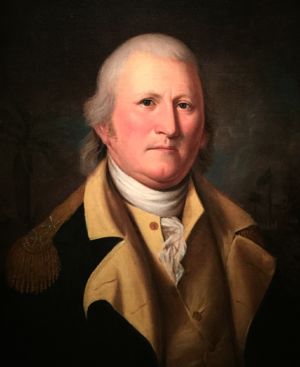| Preceded by 34th Governor Benjamin Guerard 37th Governor Charles Pinckney |
William Moultrie 35th Governor of South Carolina 1785—1787and 1792—1794 |
Succeeded by 36th Governor Thomas Pinckney 38th Governor Arnoldus Vanderhorst |
Contents |
Biography
- William Moultrie was a planter and politician who became a general from South Carolina in the American Revolutionary War. As colonel leading a state militia, in 1776 he prevented the British from taking Charleston, and Fort Moultrie was named in his honor.
- 1911 Encyclopædia Britannica, Volume 18
- MOULTRIE, WILLIAM</b> (1730-1805), American soldier, was born in Charleston, South Carolina, on the 23rd of November 1730. His father, a physician, and a graduate of the University of Edinburgh, migrated to Charleston before 1729. The son was elected to the Commons House of the Assembly in 1754, 1769 and 1772; and in 1760 he was captain of a provincial regiment in the expedition under Governor William H. Lyttelton against the Cherokees. Although he was connected by many ties to the British, he espoused the American cause on the outbreak of the War of Independence, and was a member of the first provincial congress (1775) of South Carolina, which in June made him a colonel of the Second South Carolina regiment; and he was a member of the second provincial congress (1775-1776). On Fort Johnson, on James Island in Charleston harbour, he raised what is said to have been the first American battle-flag blue, with a white crescent in the dexter corner, inscribed with the word “Liberty”; the flag was devised by him in September 1775. In March 1776 he took command of a palmetto fort which he had built on Sullivan's Island, off Charleston, which he held against the attack of Admiral Sir Peter Parker on the 28th of June, and which soon after the battle was renamed Fort Moultrie by the General Assembly. He was thanked by Congress, was made a brigadier-general in the continental army in September 1776, and was placed in command of the department of Georgia and South Carolina. He dislodged the British from Beaufort, South Carolina, in February 1779, and in April made it possible for the city of Charleston to put itself into a state of defense by delaying the advance of General Augustine Prevost. He was one of those who advised against the surrender of Charleston, where he commanded the garrison until the arrival of General Benjamin Lincoln. His imprisonment after the surrender of Charleston (May 1780) lasted until his exchange with others for General Burgoyne in February 1782. In October 1782 he was made a major-general. He was governor of South Carolina in 1785-1787 and in 1792-1794. He died in Charleston on the 27th of September 1805.
- The Moultries page 257
- JSTOR Early Journal Content, The South Carolina Historical and Genealogical Magazine
Publication
Burial
- Fort Moultrie, Sullivan Island, Charleston, Charleston, South Carolina
Legacy
- Moultrie County, Illinois is named in his honor.
Sources
- Find A Grave Memorial# 23285
- William Moultrie on Wikipedia
- The Family Magazine (Redfield & Lindsay, 1834-5) Vol. 2, Page 317-9
Contributors
No known carriers of William's DNA have taken a DNA test. Have you taken a test? If so, login to add it. If not, see our friends at Ancestry DNA.
This week's featured connections are French Notables: William is 9 degrees from Napoléon I Bonaparte, 14 degrees from Gilbert du Motier de La Fayette, 15 degrees from Sarah Bernhardt, 31 degrees from Charlemagne Carolingian, 21 degrees from Sidonie-Gabrielle Colette, 11 degrees from Pierre Curie, 23 degrees from Simone de Beauvoir, 13 degrees from Philippe Denis de Keredern de Trobriand, 14 degrees from Camille de Polignac, 15 degrees from Henri-Gustave Joly de Lotbinière, 18 degrees from Claude Monet and 17 degrees from Aurore Dupin de Francueil on our single family tree. Login to see how you relate to 33 million family members.
M > Moultrie > William Moultrie
Categories: 2nd South Carolina Regiment, Continental Army, American Revolution | Prisoners of War, American Revolution | Charleston, South Carolina | Fort Moultrie, Charleston, South Carolina | Continental Army Generals, American Revolution | South Carolina Governors | Namesakes US Counties | South Carolina, Notables | Notables | NSDAR Patriot Ancestors | NSSAR Patriot Ancestors





http://www.archives.gov/research/military/american-revolution/pictures/images/revolutionary-war-103.jpg